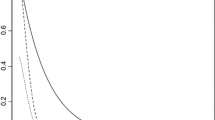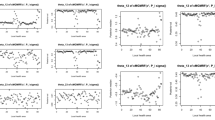Abstract
This work describes a Gaussian Markov random field model that includes several previously proposed models, and studies properties of its maximum likelihood (ML) and restricted maximum likelihood (REML) estimators in a special case. Specifically, for models where a particular relation holds between the regression and precision matrices of the model, we provide sufficient conditions for existence and uniqueness of ML and REML estimators of the covariance parameters, and provide a straightforward way to compute them. It is found that the ML estimator always exists while the REML estimator may not exist with positive probability. A numerical comparison suggests that for this model ML estimators of covariance parameters have, overall, better frequentist properties than REML estimators.
Similar content being viewed by others
References
Besag J, Kooperberg C (1995) On conditional and intrinsic autoregressions. Biometrika 82: 733–746
Besag J, York J, Mollié A (1991) Bayesian image restoration, with two applications in spatial statistics (with discussion). Ann Inst Stat Math 43: 1–59
Birkes D, Wulff SS (2003) Existence of maximum likelihood estimates in normal variance-components models. J Stat Plan Inference 113: 35–47
Chellappa R, Jain A (1993) Markov random fields: theory and application. Academic Press, Boston
Clayton D, Kaldor J (1987) Empirical Bayes estimates of age-standardized relative risks for use in disease mapping. Biometrics 43: 671–681
Cressie NAC (1993) Statistics for spatial data, revised edition. Wiley, New York
Cressie N, Chan NH (1989) Spatial modeling of regional variables. J Am Stat Assoc 84: 393–401
Cressie N, Lahiri SN (1996) Asymptotics for REML estimation of spatial covariance parameters. J Stat Plan Inference 50: 327–341
Demidenko E, Massam H (1999) On the existence of the maximum likelihood estimate in variance components models. Sankhyā A 61: 431–443
Dryden ID, Ippoliti L, Romagnoli L (2002) Adjusted maximum likelihood and pseudo-likelihood estimation for noisy Gaussian Markov random fields. J Comput Graph Stat 11: 370–388
Ferreira MAR, De Oliveira V (2007) Bayesian reference analysis for Gaussian Markov random fields. J Multivar Anal 98: 789–812
Harville DA (1974) Bayesian inference for variance components using only error contrasts. Biometrika 61: 383–385
Harville DA (1997) Matrix algebra from a statistician’s perspective. Springer, New York
Leroux BG, Lei X, Breslow N (1999) Estimation of disease rates in small areas: a new mixed model for spatial dependence. In: Halloran ME, Berry D (eds) Statistical models in epidemiology, the environment and clinical trials. Springer, New York, pp 135–178
Mardia KV, Marshall RJ (1984) Maximum likelihood estimation of models for residual covariance in spatial regression. Biometrika 71: 135–146
Pettitt AN, Weir IS, Hart AG (2002) A conditional autoregressive Gaussian process for irregularly spaced multivariate data with application to modelling large sets of binary data. Stat Comput 12: 353–367
Puntanen S, Styan GPH (1989) The equality of the ordinary least squares estimator and the best linear unbiased estimator (with discusssion). Am Stat 43: 153–163
Richardson S, Guihenneuc C, Lasserre V (1992) Spatial linear models with autocorrelated error structure. The Statistician 41: 539–557
Rue H (2001) Fast sampling of Gaussian Markov random fields. J R Stat Soc Ser B 65: 325–338
Rue H, Follestad T (2002) Gmrflib: a C-library for fast and exact simulation of Gaussian Markov random fields. Technical report, Department of Mathematical Sciences, Norwegian University of Science and Technology, Trondheim, Norway
Rue H, Held L (2005) Gaussian Markov random fields: theory and applications. Chapman & Hall, Boca Raton
Sun D, Tsutakawa RT, Speckman PL (1999) Posterior distribution of hierarchical models using CAR(1) distributions. Biometrika 86: 341–350
Zimmerman DL, Harville DA (1991) A random field approach to the analysis of field-plot experiemnts and other spatial experiments. Biometrics 47: 223–239
Zyskind G (1967) On canonical forms, non-negative covariance matrices and best and simple least squares linear estimators in linear models. Ann Math Stat 38: 1092–1109
Author information
Authors and Affiliations
Corresponding author
Rights and permissions
About this article
Cite this article
De Oliveira, V., Ferreira, M.A.R. Maximum likelihood and restricted maximum likelihood estimation for a class of Gaussian Markov random fields. Metrika 74, 167–183 (2011). https://doi.org/10.1007/s00184-009-0295-7
Received:
Published:
Issue Date:
DOI: https://doi.org/10.1007/s00184-009-0295-7




